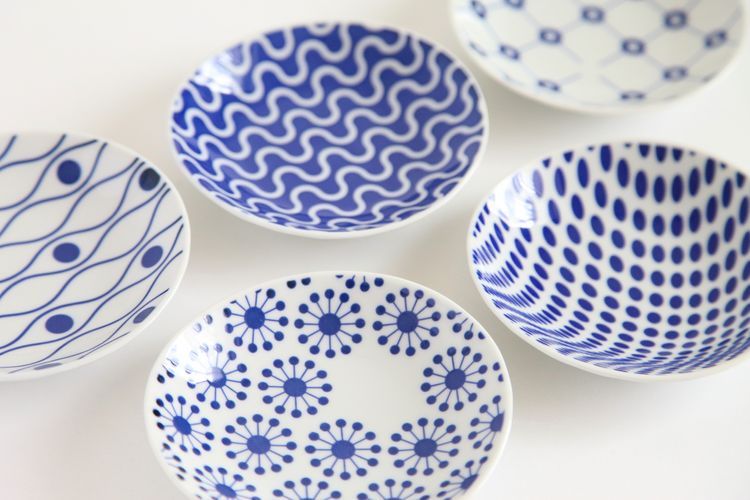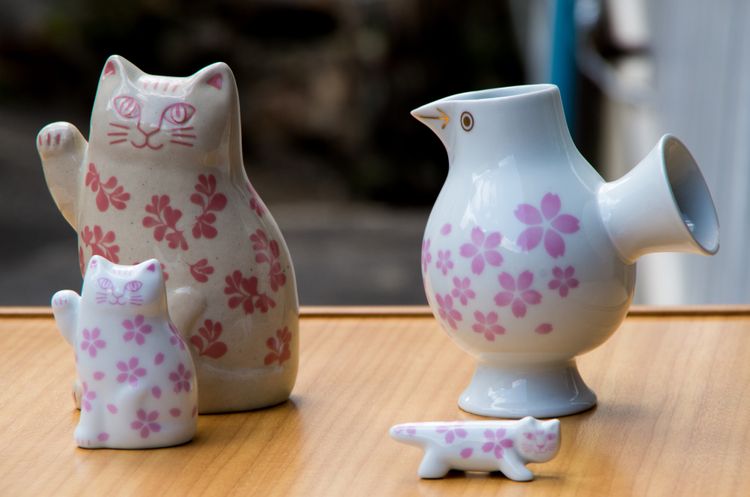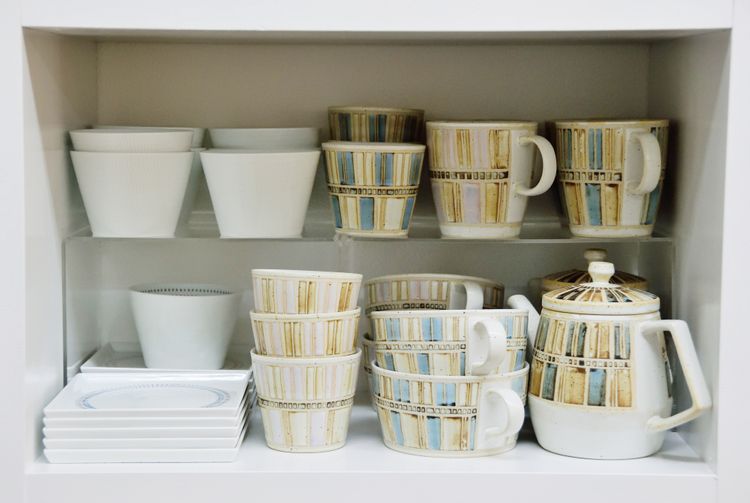The Hasami style of ceramics originated in the town of Hasami, Nagasaki Prefecture, in northwestern Kyushu. Boasting a history that’s 400 years old, Hasami ware is one of the most popular kinds of ceramics in Japan, which has helped make Nagasaki the third most prolific maker of everyday Japanese tableware in the country. Hasami originally produced pottery, but after finding deposits of pottery stones in the area, they switched focus to white and blue ceramics. The most interesting thing about Hasami ware is its uniquely specialized production process which has made it possible to produce these high-quality pieces on a mass scale. The most common image of Hanami ware that people have is white porcelain with blue indigo patterns painted on it, but modern wares in this style now sport many different designs. Hasami ware has also been designated as a traditional Japanese craft by the Ministry of Economy, Trade and Industry.
The History of Hasami Ware

Hasami ware (known in Japan as Hasami-Yaki) is pottery that developed in northwestern Kyushu around the town of Hasami in Higashisonogi, Nagasaki Prefecture.
Its history goes back more than 400 years to the Imjin War (the Japanese invasion of Korea) which lasted from 1592 to 1598. The feudal lord of Hasami Village (the present-day town of Hasami), Yoshiaki Omura, participated in that war and upon his return, brought a Korean potter with him back to Japan. This potter then taught the locals the art of Korean pottery, and Omura constructed multi-chamber climbing kilns (where a series of connected kiln chambers are built on a slope, one on top of the other) in Hatanohara, Furusaraya, and Yamanita, marking the beginning of Hasami ware.
At first, they produced glazed earthenware made from clay, but later turned to porcelain after porcelain stone deposits were discovered in Hasami. In 1630, all of the local production switched completely from earthenware to porcelain, which came in two varieties: “sometsuke,” a white porcelain base painted with patterns which are then covered with transparent glaze and fired, and “aoji” (celadon porcelain), porcelain coated with a green-colored glaze.

In the mid-17th century, a civil war stopped China from exporting their porcelain abroad. That’s when the world turned their attention to Japan, and Hasami ware exports began to climb. Soon, the porcelain became famous around the world. However, 1690 marked the end of China’s civil war and a return to pottery exports, which caused a dip in the sale of Hasami products, prompting makers to again turn their attention to the domestic market. In 1655, Omura’s domain set up the Sarayama public office to manage the production of Hasami porcelain and help make it the region’s specialty product. As a result, in the late Edo Period (1781 – 1867), the domain became the biggest producer of sometsuke porcelain in all of Japan.
With the development of railway lines in the Meiji Period (1868 – 1912), it became commonplace to transport products via trains. Hasami took advantage of that, using the Arita shipping station to deliver their products to every corner of the country. Soon, people started referring to porcelain from the Hasami and Arita regions (another famous porcelain-producing region) collectively as “Arita ware” (“Arita-Yaki” in Japanese). However, around the year 2000, Japan struggled with an influx of counterfeit goods, necessitating stricter authentication measures regarding a product’s place of production. Since then, all pottery from Hasami has been required to be identified as “Hasami ware.”

Some of the most famous examples of historical Hasami ware include the kurawanka bowl and the konpura bottle (pictured above). The origin of the name “kurawanka” goes back to the Edo Period, when merchants in boats would approach ships on the Yodo River and try to sell them food and alcohol by asking “Mochi kurawanka? Sake kurawanka?” meaning “Won’t you buy some mochi (rice cake)? Won’t you buy some sake?” in the local dialect. At the time, porcelain was considered a luxury product, but the kurawanka bowls were mass produced, so they were quite affordable and thus beloved by commoners.
Konpura bottles are Hasami ceramics produced from around the end of the Edo Period. They were mainly used to preserve alcohol and soy sauce meant for exports. Initially, those products were transported in wooden casks, but due to spending a long time at sea, the cask-stored soy sauce started to lose its taste, so Hasami craftsmen created a special bottle that would help keep it fresh.
The Characteristics of Hasami Ware

Most types of pottery tend to have specific characteristics depending on where they are produced, but not Hasami ware. It’s even said that the characteristic of Hasami ware is that it has no specific characteristics. Indeed, the ceramics produced in Hasami have never been held back by tradition or production method and instead have continued to change and update through the years. This has made it a favorite of the common folk for over 400 years. From old-timey patterns and simple designs to wares featuring more American or northern European motifs, there is a Hasami dish out there for anyone.

By employing a system of specialization, where each craftsman handles just one part of the production process, high-quality Hasami ware is able to be produced at a large scale. The whole process is broken into four stages: the “kataya” handles the production of plaster molds, the “kijiya” creates the porcelain clay, the “kamamoto” fires the porcelain, and the “uwaeya” creates and applies designs to the fired pieces. It was this division of labor, with a specialist handling each individual step in the process, that enabled Hasami ware to be produced in high quantities while guaranteeing an equally high quality. Even today, these wares are very popular in Japan, making up 16% of all domestic tableware dishes.
In 1978, Hasami ware was designated as a Traditional Japanese Craft by the Ministry of Economy, Trade and Industry.
Hasami Ware Today

In 2010, Maruhiro, a Hasami ware assembling wholesaler, announced a new brand called “HASAMI” and instantly helped bring the porcelain back into the spotlight. Their mugs with never-before-seen modern pop designs became a hit all over Japan, being sold everywhere from general to apparel stores and attracting plenty of young buyers. This led to an increase in sales of Hasami ware and a revitalization of the areas that produce them. As a result, the annual Hasami Pottery Festival* attracted around 300,000 people, and that number has been growing every year since then.
People used to think of Hasami wares as luxury items but now they’ve become known as sturdy, everyday dishes sold at affordable prices. It’s why so many people love them. Because it isn’t limited to any one design or production method, Hasami ware can change with the times and fit the lifestyles of people in any time period. Currently it has become quite popular among young people and women.
* The 2020 festival was canceled. The 2021 festival is planned for late April (unconfirmed as of yet).
Featured Products
Sakai Hasami Ware Ceramic Pot, Majolica Design (Super Stainless Steel Tea Strainer Included)

This pot features a design that’s undoubtedly Hasami ware, but one that’s also not bound by tradition. It supposedly originated with a British porcelain producer that came up with a product called “Majolica tile,” which became the basis for this pattern. The pot comes with a steel tea strainer, so it’s very easy to use.
natural69 Swatch Length Angle Dishes Set of 5

These rectangular plates feature the familiar Hasami blue design patterns on white porcelain. They’re just the right size, measuring 23.5 cm x 14 cm, and can be used to serve not just Japanese dishes, but all kinds of food while bringing out their inner beauty.
Related articles:
▶ Traditional Japanese Crafts: The Complete Guide to Japanese Ceramics
▶ The Complete Guide to Traditional Japanese Crafts
▶ 5 Japanese Plates That Would Brighten Up Any Dining Table
If you want to give feedback on any of our articles, you have an idea that you'd really like to see come to life, or you just have a question on Japan, hit us up on our Facebook, Twitter, or Instagram!
*These products may not be able to be shipped to certain countries. Please see the retailer's website for more information.
The information in this article is accurate at the time of publication.
